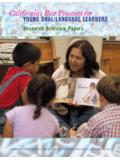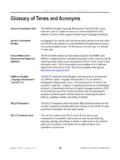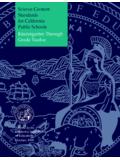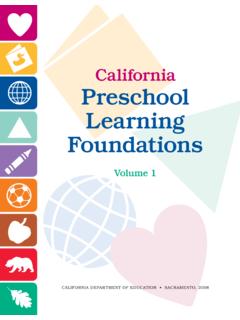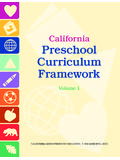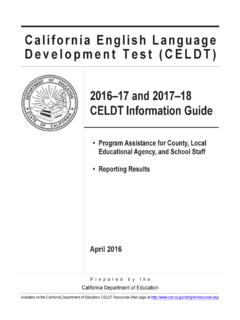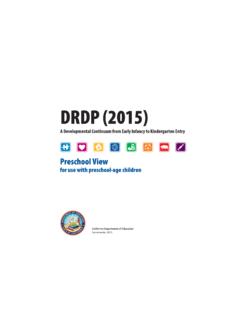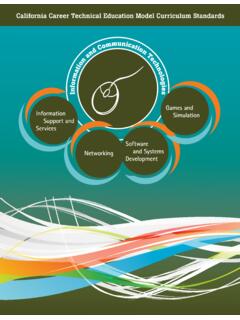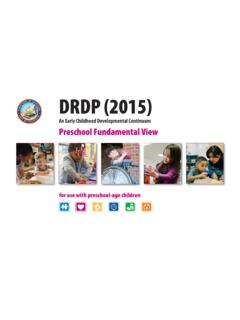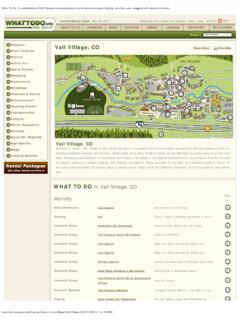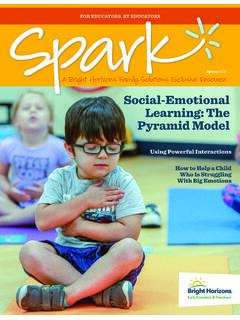Transcription of Family Partnerships and Culture - Child Development (CA ...
1 BEST PRACTICES FOR PLANNING CURRICULUM FOR YOUNG CHILDRENand California Department of Education Sacramento, 2016 Publishing InformationFamily Partnerships and Culture was developed by the Early Education and Support Division, California Department of Education. This publication was edited by Faye Ong, working in cooperation with Laura Bridges, Child Development Consultant. It was designed and prepared for online posting by the staff of CDE Press, with the cover designed by Tuyet Truong. It was published by the Department of Education, 1430 N Street, Sacramento, CA 95814. It was distributed under the provisions of the Library Distribution Act and Government Code Section 978-0-8011-1758-9 2016 by the California Department of EducationAll rights Publications and Educational ResourcesFor information about publications and educational resources available from the California Department of Education (CDE), visit or call the CDE Press sales office at of this document for resale, in whole or in part, is not guidance in Family Partnerships and Culture is not binding on local educational agencies or other entities.
2 Except for the statutes, regulations, and court decisions that are referenced herein, the document is exemplary, and compliance with it is not mandatory. (See Education Code Section )CONTENTSA Message from the State Superintendent of Public Instruction ..vAcknowledgments ..viForeword ..xIntroduction ..1 Part I. Guiding Principles for Developing Cultural Competence ..5 Cognitive Cultural Competence .. 6 Affective Cultural Competence .. 9 Cultural Responsiveness .. 10 NAEYC Cultural Competence Project ..17 Part II. Understanding Culture ..19 Definition of Culture .. 20 Why an Understanding of Culture Is Important .. 22 Distinguishing Between Ethnicity and Culture .. 25 Learning About Cultures .. 27 Exploring Dimensions of Culture .. 30 Collectivist Versus Individualist Cultures .. 39 Myths About Cultures.
3 42 Support Development of the Home Language ..47 Part III. Understanding Contemporary Families and Households ..52 Family Composition .. 55 Culturally Based Family Strengths ..61 Contents | iii Family Strains .. 63 Impact of Family Stress .. 72 Part IV. Culture , Family Life, and the Early Childhood Curricula ..75 Implications of Cultural and Family Experiences for Teaching and Learning .. 78 Curriculum Frameworks .. 79 Conclusion .. 95 Appendix: Questions to Expand Understanding of Families ..99 Glossary ..106 References ..108 Additional Resources and References .. 114iv | Family Partnerships and CultureA Message | vA Message from the State Superintendent of Public InstructionI am pleased to present Family Partnerships and Culture , a publication providing early childhood education program administrators and teachers with guidance on practices that support the Development of Partnerships with families and inclusion of children s cultural experiences as essential parts of planning curriculum.
4 Families can be invalu-able partners in early childhood programs efforts to enhance early learning and pre-pare children for school. Because the Family s approach to guiding early Development is influenced by adult Family members Culture or cultures, a key aspect of developing Partnerships with families is to be responsive to their cultures. This publication pro-motes understanding of children s cultural or multicultural experiences at home and helps teachers use those experiences as building blocks for teaching and learning in early education settings. It complements the resources of the California Department of Education s Early Learning and Development System, particularly the California infant / toddler Curriculum Framework and the California Preschool Curriculum Frame-work, Volumes One, Two, and Three.
5 Family Partnerships and Culture draws upon both current research and evidence-based practice. This publication offers a comprehensive view of how to include Family and Culture in curriculum planning. Developing effective Partnerships with families involves building on Family and cultural strengths and being supportive of families as they try to manage stress in their daily lives. The vision of Family members, teachers, and program directors working together to enhance young children s learning holds great promise. Partnerships that recognize Family strengths and create a context for supporting families will augment other best practices in early education programs. The result is high-quality early learning experiences that contribute to children s well-being and successful Development . Tom TorlaksonState Superintendent of Public Instruction ACKNOWLEDGMENTSThe Development of Family Partnerships and Culture involved many people.
6 The following groups contributed: project leaders, principal writers, additional writers, reviewers, universal design advisers, consultants and reviewers, project staff and advisers from the WestEd Center for Child and Family Studies, staff from the California Department of Education (CDE), early childhood education stakeholder organizations, and participants in the formative and review focus LeadersThe following staff members are gratefully acknowledged for their contributions: Peter L. Mangione and Katie Monahan, Writers Special thanks are extended to the principal writers for their expertise and contributions. Oscar Barbarin, Tulane University Peter L. Mangione, WestEdAdditional WritersParticular thanks are also extended to the following consultants for their substantive contributions to the project: Linda Brault, WestEd Janet Gonzalez-Mena, Program for infant toddler Care; Napa Valley College Gisela Jia, City University of New York, Lehman College Alison Wishard-Guerra, University of California, San DiegoReviewerParticular thanks are extended to the following reviewer for her contribution to the project: Kim Nall, Colusa Indian Community CouncilNote: The names and affiliations of the individuals named were current at the time this publication was developed.
7 Vi | Family Partnerships and CultureUniversal Design AdvisersThe following universal design experts are gratefully acknowledged for their contributions: Maurine Ballard-Rosa, California State University, Sacramento Linda Brault, WestEdWestEd Center for Child and Family Studies Project Staffand Advisers Brittany Auslander Charlotte Tilson Linda Brault Ann-Marie Wiese Melinda Brookshire Megan Wilson Jenae Leahy Caroline Pietrangelo Owens Teresa Ragsdale Amy Schustz-AlvarezCalifornia Department of EducationThanks are extended to the following CDE staff members: Richard Zeiger, Chief Deputy Superintendent of Public Instruction.
8 Lupita Cortez Alcal , Deputy Superintendent, Instruction and Learning Support Branch; Debra McMannis, Director, Early Education and Support Division; Cecelia Fisher-Dahms, Administrator, Quality Improvement Office, Early Education and Support Division; and Laura Bridges, Child Development Consultant, Early Education and Support Division, for ongoing revisions and recom-mendations. During the lengthy Development process, many CDE staff members were involved at various levels. Additional thanks are extended to Gail Brodie, Sy Dang Nguyen, Luis Rios, and Charles Vail, Early Education and Support Division; and Meredith Cathcart, Special Education Childhood Education Stakeholder OrganizationsRepresentatives from many statewide organizations provided input that affected various aspects of this publication.
9 Action Alliance for Children (AAC) Alliance for a Better Community Asian Pacific Islanders California Action Network (APIsCAN) Association of California School Administrators Baccalaureate Pathways in Early Childhood & Education (BPECE) Black Child Development Institute (BCDI), Sacramento Affiliate California Alliance of African American Educators (CAAAE) California Association for Bilingual Education (CABE)Acknowledgments | vii California Association for the Education of Young Children (CAEYC) California Association for Family Child Care (CAFCC) California Association of Latino Superintendents and Administrators (CALSA) California Child Care Coordinators Association (CCCCA) California Child Care Resource and Referral Network (CCRRN) California Child Development Administrators Association (CCDAA) California Commission on Teacher Credentialing (CCTC) California Community College Early Childhood Educators (CCCECE) California Community Colleges, Chancellor s Office (CCCCO) California Council for the Social Studies (CCSS) California County Superintendents Educational Services Association (CCSESA) California Early Childhood Mentor Program California Early Reading First Network California Federation of Teachers (CFT) California Head Start Association (CHSA) California Kindergarten Association (CKA) California Preschool Instructional Network (CPIN) California Professors of Early Childhood Special Education (CAPECSE) California School Boards Association California Science Teachers Association (CSTA)
10 California State PTA California State University Office of the Chancellor California Teachers Association Californians Together Campaign for High Quality Early Learning Standards (CHQELS) Child Development Policy Institute (CDPI) Child Development Training Consortium (CDTC) Children Now The Children s Collabrium Council for Exceptional Children/California Division for Early Childhood (Cal-DEC) Council of CSU Campus Childcare (CCSUCC) Curriculum Alignment Project (CAP) Curriculum and Instruction Steering Committee (CISC) Desired Results access Project Drew Child Development Corporation English Language Learners Preschool Coalition (ELLPC) Federal/State/Tribes Collaboration Workgroup Fight Crime: Invest in Kids California First 5 Association of Californiaviii | Family Partnerships and Culture First 5 California, California Children & Families Commission Head Start State-Based Training and Technical Assistance Office for California infant Development Association California (IDA California) Learning Disabilities Association of California (LDCA) Los Angeles Universal Preschool (LAUP) Mexican American Legal Defense and Educational Fund (MALDEF) Migrant Education Even Start (MEES) Migrant Head Start National Council of La Raza (NCLR) David and Lucile Packard Foundation.

